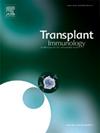使用下一代测序(NGS)平台研究人类白细胞抗原(HLA)等位基因和单倍型频率:印度500多人的单中心研究!
IF 1.4
4区 医学
Q4 IMMUNOLOGY
引用次数: 0
摘要
背景:人类白细胞抗原(HLA)系统的巨大多样性被认为与各种疾病、人类学、群体遗传学和移植有关。HLA等位基因在不同人群中的频率对研究和临床应用都至关重要。本研究测定了595例接受实体器官移植(SOT)和造血祖细胞移植(HPCT)患者的所有HLA I类和II类位点的等位基因和单倍型频率。方法:采用下一代测序(NGS)平台对HLA- a、B、C、DRB1和DQB1进行高分辨率HLA分型。结果:所有hla中最常见的等位基因为A位点的A*11:01:01(0.1849)、A*24:02:01(0.1202)和A*01:01:01 (0.1143), B位点的B*40:06:01(0.1050)、B*52:01:01(0.0950)和B*51:01:01 (0.0723), C位点的C*07:02:01(0.1303)、C*04:01:01(0.1227)和C*15:02:01 (0.1185), DRB1位点的DRB1*07:01:01(0.1286)、DRB1*15:01:01(0.1134)和DRB1*03:01:01 (0.0966), DQB1的DQB1*06:01:01(0.1849)、DQB1*03:01:01(0.1471)和DQB1*02:02:01(0.0966)。最常见的(> 2 %)five-locus ~ B ~ C ~ DRB1 ~ DQB1单是* 33:03:01 ~ B * 44:03:02 ~ C * 07:06:01 ~ DQB1 * 02:02:01 ~ DRB1 * 07:01:01(2.97 %),A * 26:01:01 ~ B * 08:01:01 ~ C * 07:02:01 ~ DQB1 * 02:01:01 ~ DRB1 * 03:01:01(2.23 %)和一个* 02:11:01 ~ B * 40:06:01 ~ C * 15:02:01 ~ DQB1 * 06:01:01 ~ DRB1 * 15:01:01(2.15 %)。在所有检测位点中,HLA-B位点多态性最多,HLA-DQB1位点多态性最少。结论:该数据反映了印度人群HLA-A、B、C、DRB1、DQB1等位基因的分布及其单倍型频率。本文章由计算机程序翻译,如有差异,请以英文原文为准。
Study of human leukocyte antigen (HLA) allele and haplotype frequency using next generation sequencing (NGS) platform: Single-centre study of over 500 individuals in India!
Background
The huge diversity of Human Leukocyte Antigen (HLA) system is well-known to be associated with various diseases, anthropology, population genetics, and transplantation. The frequencies of HLA alleles in different populations are crucial for both research and clinical applications. This study determined the allelic and haplotype frequencies of all HLA class I and class II loci in 595 consecutive samples from patients who underwent solid organ transplantation (SOT) and hematopoietic progenitor cell transplantation (HPCT).
Method
High-resolution HLA typing for HLA-A, B, C, DRB1, and DQB1 was conducted using a next generation sequencing (NGS) platform.
Results
The most frequent alleles observed among all HLAs were A*11:01:01 (0.1849), A*24:02:01 (0.1202) and A*01:01:01 (0.1143) in A locus, B*40:06:01 (0.1050), B*52:01:01 (0.0950) and B*51:01:01 (0.0723) in B locus, C*07:02:01 (0.1303), C*04:01:01 (0.1227) and C*15:02:01 (0.1185) in C locus, DRB1*07:01:01 (0.1286), DRB1*15:01:01 (0.1134) and DRB1*03:01:01 (0.0966) in DRB1 locus, and DQB1*06:01:01 (0.1849), DQB1*03:01:01 (0.1471) and DQB1*02:02:01 (0.0966) in DQB1 locus. The most frequent (>2 %) five-locus A ∼ B ∼ C ∼ DRB1 ∼ DQB1 haplotypes were A*33:03:01 ∼ B*44:03:02 ∼ C*07:06:01 ∼ DQB1*02:02:01 ∼ DRB1*07:01:01 (2.97 %), A*26:01:01 ∼ B*08:01:01 ∼ C*07:02:01 ∼ DQB1*02:01:01 ∼ DRB1*03:01:01 (2.23 %) and A*02:11:01 ∼ B*40:06:01 ∼ C*15:02:01 ∼ DQB1*06:01:01 ∼ DRB1*15:01:01(2.15 %). Among all tested loci, the HLA-B locus had the most polymorphism, whereas the HLA-DQB1 locus had the least polymorphism.
Conclusion
The data represent the distribution of HLA-A, B, C, DRB1, DQB1 alleles and their haplotype frequencies among the population in India.
求助全文
通过发布文献求助,成功后即可免费获取论文全文。
去求助
来源期刊

Transplant immunology
医学-免疫学
CiteScore
2.10
自引率
13.30%
发文量
198
审稿时长
48 days
期刊介绍:
Transplant Immunology will publish up-to-date information on all aspects of the broad field it encompasses. The journal will be directed at (basic) scientists, tissue typers, transplant physicians and surgeons, and research and data on all immunological aspects of organ-, tissue- and (haematopoietic) stem cell transplantation are of potential interest to the readers of Transplant Immunology. Original papers, Review articles and Hypotheses will be considered for publication and submitted manuscripts will be rapidly peer-reviewed and published. They will be judged on the basis of scientific merit, originality, timeliness and quality.
 求助内容:
求助内容: 应助结果提醒方式:
应助结果提醒方式:


